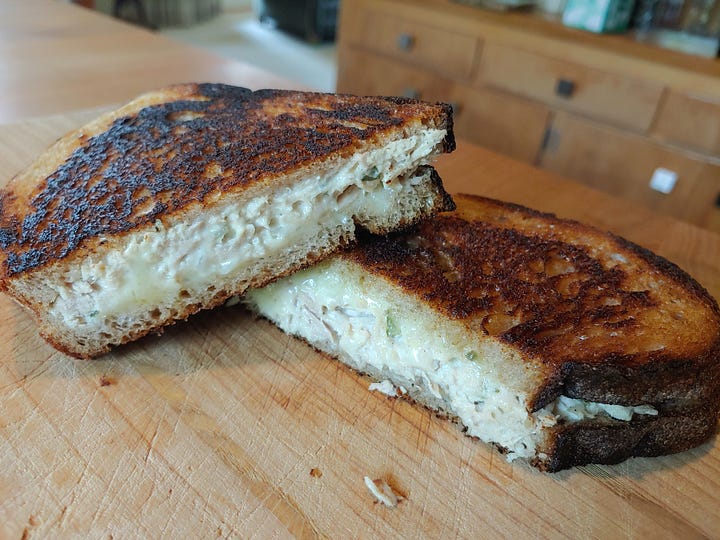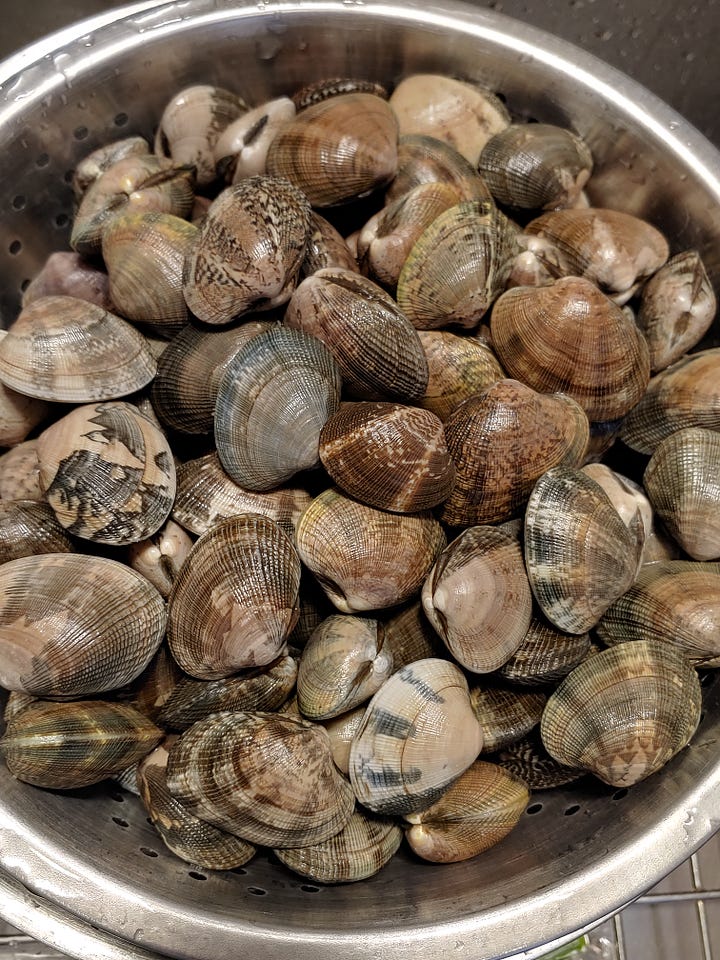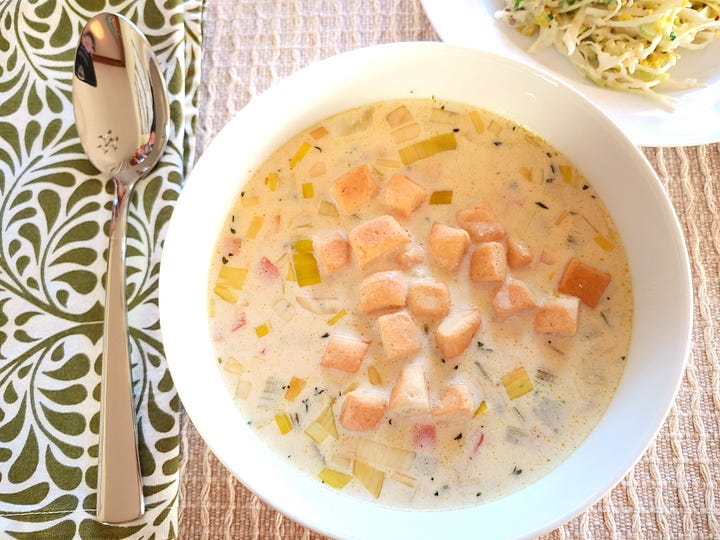I’m kind of bucking the traditional summertime trend here, opting to not writing about the usual warm-weather topics of grilling and big dinnertime salads and such. At least not for this moment. Both are in frequent rotation around here now, and sometimes—grilling in particular—more or less year round. Until I get to some 2024 reflections on those summery themes, these issues include some grilling and salad considerations I shared last year.
For whatever reason, tuna melts have been on my mind a lot this year. And as is so often the case, once something’s on your mind that thing suddenly seem to appear various places, as if your thoughts are somehow in sync with the universe—when usually, it’s more true that the thing was always there and you’d just not been in a frame of mind to notice it.
Tuna melt was on the menu when out for lunch with a friend at a local bakery a couple of months ago, a very good one with albacore and white cheddar on their sourdough bread. Lunch at a neighborhood brewpub with my husband recently featured another tuna melt, this one with roasted green chiles—I’ll definitely be ordering that again.
During my work days every now and then I open a can of tuna, making a quick tuna salad that I invariably eat as is on crackers. One day a couple years ago I had the urge to indulge in a tuna melt for the first time in a long while. None too fancy, it may even have been just tuna & mayo in the mix, though minced onion and/or pickle are frequent additions. Sharp cheddar cheese, which is almost always in the fridge. This is one time I will pull out some old-school white sandwich bread (sometimes tucked in the freezer), to be slathered generously with soft butter before browning well in a skillet. Friends swooned a bit when I shared the pic below that day.
This week I made myself another tuna melt for lunch, with the addition of capers, onion, and pickle in the tuna, and this time gruyère that happens to be on hand. Oh, and I used a more rustic whole wheat—fresh out of sandwich bread right now.


My Thoughts on Tuna Melt Components
The Requisites
the bread: not too soft, not too dense, just right; classic sandwich bread and sourdough are frequent top picks
the format: classic 2-slice sandwich or open-faced
the tuna: most often canned or jarred, this prime element of the sandwich very personal, oil- or water-packed, fancy/everyday, etc.; some may opt to cook fresh tuna steaks for their sandwich (like my pal Ken you’ll read more about below), or use leftover cooked fish
the cheese: it must be melty!! cheddar is a classic, American cheese perhaps even more so for its quintessential meltiness, I prefer sharp cheddar for its deeper flavor; gruyère, Swiss delicious options, mozzarella supremely melty and mild
the mayo: I’m 100% Best Foods here, some like other types such as Kewpie, etc.
Additional Character:
crunchy elements: celery, onion (yellow, red, green, shallot)
pickle-y elements: pickles (surely never sweet…right?!), cornichon, capers, maybe pickled onion/shallot, pickled peppers (I sure do love Mama Lil’s “mildly spicy” version!)
flavor accents: lemon juice and/or zest, herbs (often dill), celery seed/salt
other “cook’s choice” options (some wacky stuff out there, saw one version with walnuts…hmmm)
And, well, there’s the whole other factor of technique too, how the sandwich is put together and cooked. Skillet, griddle, panini press? Bread pre-toasted? I have seen folks swear that it’s better to use mayonnaise to spread on outer surface of the bread for grilling, but I will always be #teambutter. Yet another variable to add to the mix for personalizing your idea of tuna melt perfection. I have a big griddle between the 4 burners on my stove which would be ideal for tuna melts, though I rarely heat it up for just one sandwich.
In her 2020 cookbook Modern Comfort Food, Ina Garten includes “Ultimate Tuna Melts” in the mix. For her version, those components play out thusly:
white bread, namely a specific Pepperidge Farm bread she uses
open-faced
“good Spanish tuna packed in oil” as she says in the headnote, noting Ortiz as the brand she uses
Swiss for the cheese, noting Emmentaler an option
“good mayonnaise such as Hellmann’s” which is the East Coast version of my preferred Best Foods
her additions include celery, green onions, fresh dill, lemon juice and optional anchovy paste, with microgreens scattered over after the sandwiches are broiled to melt the cheese
I may be a fan of tuna melts, but at least one of my friends, Ken Albala, is miles ahead of me in fandom and creative versions of tuna melts. A couple months ago he posted this on FB, with delicious-looking evidence in the accompanying photo: “There is no question that a tuna melt is the finest sandwich. Yes, open faced. But with fresh tuna, sourdough, Irish butter, mozzarella, and a sprinkle of furikake, simple yet enthralling. #breakfast”.
Furikake*—a Japanese seasoning mix with countless versions , usually containing dried seaweed and sesame seeds as a starting point—is a brilliant addition that hadn’t occurred to me before. And that he had this combo for breakfast, that’s a power move in the tuna-melt-fan realm. We chatted online for a bit, complete with photos of other versions he’s made—one with pickled eggs and horseradish in the tuna mix, another using smoked trout instead of tuna. Ken mentioned that there’s a section of his next cookbook that delves into this theme of tuna melts and similar types of sandwiches. Opulent Nosh: A Cookbook for Audacious Appetites will be out in September; I anticipate finding plenty of inspiration in those pages.
So many different variations possible, tuna melts can take on countless personalities. If you’re a big fan of tuna melts, or even a casual one for that matter, and want to share the components of your ideal tuna melt, please share them in the comments below.
*Speaking of furikake, as mentioned there are loads of varieties out there. One I have in my cupboard is one of this year’s winners of the Good Food Awards. I was honored to be a judge for the fish category this year, and the Ume Shiso Furikake from Daybreak Seaweed was among the finalists. I’m far from a furikake aficionado, but did really love this product—briny character from the seaweed with dried shiso, dried umebochi (pickled plum) and sesame seeds. With some tuna leftover from yesterday’s tuna melt mentioned above, I made another with a generous sprinkle of this furikake. Wow, next-level tuna melt. Thanks for the idea, Ken!


On Comfort Food
I’d originally planned for this issue to cover comfort food more broadly, but found the tuna melt rabbit hole big enough to consume plenty of thoughts and space here. That leaves plenty of opportunity for further comfort-seafood conversations to come.
I won’t dive deep for now (she says, not 100% convinced), but among the things that leap to mind for me when I consider the overlap of seafood and comfort food are pan-fried oysters, clam chowder, fish sticks, salmon cakes as I remember my mom making them.
In her cookbook on the topic, among other seafoody comfort foods that Ina Garten included were grilled oysters with lemon dill butter, fish chowder, lobster stew, baked cod with garlic and herb Ritz crumbs, and crab and pea risotto.
Nigella Lawson, in the pages of Cook, Eat, Repeat, extols the virtues of the “English comfort-food classic, a fish stick sandwich,” which she says is “the food that most often sustains me as I write.” She offers a recipe for Old-Fashioned Sandwich Loaf with just that kind of comfort-food use in mind. Nigella’s version of the sandwich includes Japanese mayonnaise, her homemade fermented hot sauce, and crisp iceberg lettuce— “My idea of heaven when I’m harried, hungry, and have no time to cook,” she says. Now that I am reacquainted with fish sticks and usually have some on hand, that’s a sandwich I need to make before long. Not so different from countless expressions of the fried fish sandwich one might find in venues from fast-food to upscale gastropub fare.
I posed a quick question to friends on FB a few days ago, asking what first came to mind when I asked about their favorite seafood comfort foods. With a fascinating array of 80+ responses and more still coming in, I’ve got a lot of interesting and enticing comfort-food items to consider. And it’s making clear the degree to which “comfort” is a subjective concept, whether thinking about food or not. It has me starting a list of various ways that comfort food might be defined, with a brief reflection on the fact that everyone’s personal definition may be a bit—or a lot—different. In general, they lean toward foods that are uncomplicated, nostalgic, warmly satisfying, a favorite food in its simplest form, reminiscient of a significant time and/or place in life… No wonder we love comfort foods so much.


Clam Chowder
Since clam chowder was the first comfort food a friend mentioned and many other friends have listed it among their top picks as well, here’s my recipe for it from my most recent cookbook Shellfish. As much as I love bacon and often include it in chowders, this version skips it to emphasize the briny-sweet flavor of the clams. This is a lighter style of chowder, just moderately thickened with a bit of flour. If you want to keep some of the clams in their shells for serving, feel free. Keep in mind that the clams have varying ratios of meat to shell, so the exact amount of clam meat you end up with will vary accordingly.
Makes 4 to 6 servings
2 1/2 to 3 pounds small to medium live hard-shell clams, well rinsed
1 1/2 cups water
1/4 cup unsalted butter
1 large or 2 small leeks, trimmed, cleaned, and thinly sliced (about 2 cups)
1 large carrot, cut into 1/4-inch dice (about 1 cup)
2 stalks celery, thinly sliced (about 3/4 cup)
2 tablespoons all-purpose flour
About 2 cups clam juice, shellfish stock (recipe in the book too), or water
1 1/2 teaspoons minced fresh thyme or 1/2 teaspoon dried thyme
6 ounces red new potatoes, scrubbed and cut into 1/2-inch dice
1 cup thawed frozen petite peas
1 cup half-and-half
Put the clams and water in a medium pot, set the pot over medium-high heat, and cover. After 2 to 3 minutes, gently stir the clams with a large slotted spoon. Cover the pan and continue cooking, stirring once or twice more, until all, or most all, of the clams have opened, 2 to 5 minutes longer. (Larger clams may take longer to cook, add a few extra minutes if needed.) Use the slotted spoon to transfer the opened clams to a large bowl. Continue cooking any remaining clams for a minute or two, but discard any not opened after that time. If the liquids are boiling vigorously at any point, reduce the heat a bit.
Pour the cooking liquids from the pan through a small fine sieve into a 4-cup measuring cup, leaving behind any grit in the bottom of the pot. When the clams are cool enough to handle, remove the meats, discarding the shells. Add the liquids from the bottom of the bowl to those from cooking the clams. Add enough clam juice to make 4 cups.
In the same pot (washed) or another soup pot, melt the butter over medium heat. Add the leek, carrot, and celery and cook, stirring occasionally, until tender (the carrot may not be fully tender, but mostly), 5 to 7 minutes. Sprinkle the flour over and cook for 2 minutes, stirring frequently to evenly distribute with the vegetables. Stir in the clam juice mixture and thyme, then add the potatoes. Simmer gently, stirring occasionally, until the potatoes are tender, 12 to 15 minutes; the liquid shouldn’t boil, reduce the heat a bit if needed. The chowder will thicken a bit as it cooks.
While the chowder is simmering, chop the clams, though small clams can be used as is if you like.
Once the potatoes are tender, reduce the heat to medium-low and add the clams, peas, and half-and-half. Simmer gently until heated through, 3 to 5 minutes, taking care to avoid boiling or it may curdle a bit (still perfectly fine). Season to taste with salt and pepper, then ladle the chowder into individual bowls and serve right away.





As a kid in Hawaii, canned tuna was a staple. Can't live on Spam alone....Coral is a brand canned there still. Comfort meal was a can of oil packed tuna, dumped in a hot pan, maybe some onions if we had them, throw on a little shoyu and sugar. That was all plopped on hot rice and a dash of furikaki. MMMMMMM. Another staple on our dinner table was something we called Rubberdogs....no idea why. It was tuna mixed with egg and green onion, fried as soft patties. Again, eaten with rice. No gourmet stuff, just good memories. Now I'm hungry. Cheers! Kathleen
My family love clam chowder and I haven’t made it in ages. I will try your recipe this week.